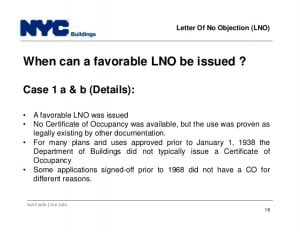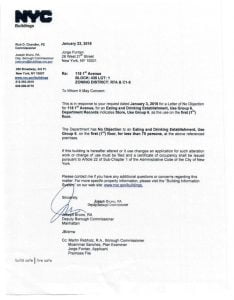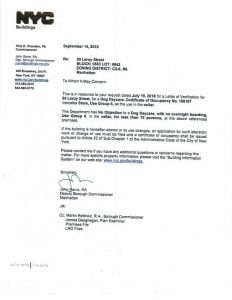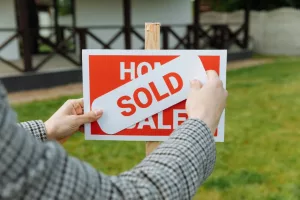Letter Of No Objection In NYC Real Estate
Go Back To Previous Page New York City’s real estate market is famous for having a lot of extra paperwork not found anywhere else in the country. NYC housing market has some of the strictest real estate laws in the nation. Also, keeping everything orderly means you need extra paperwork when buying or selling a home.
New York City’s real estate market is famous for having a lot of extra paperwork not found anywhere else in the country. NYC housing market has some of the strictest real estate laws in the nation. Also, keeping everything orderly means you need extra paperwork when buying or selling a home.
You must fill out many letters and forms when doing a transaction. One letter you might need is a Letter of No Objection in Brooklyn. But what is the meaning of a Letter of No Objection?
A DOB Letter of No Objection in NYC verifies the legal use of a building constructed before January 1st, 1938, which does not have a CO on file with the DOB. The reason is that properties built in NYC before 1938 did not need Certificates of Occupancy. We will share samples of letters of no objection certificates.
Contractors usually request an LNO to verify the legal use before filing an Alteration application with the DO. The seller of a property built before 1938 must have a C/O or a DOB Letter of No Objection on file with the DOB to close.
What Does A Letter Of No Objection in NYC Do?
LNOs are letters used for buildings built before obtaining a Certificate of Occupancy. These are letters that describe the official use of a building. It means that the Department of Buildings doesn’t object to you using a building in a certain way.
the official use of a building. It means that the Department of Buildings doesn’t object to you using a building in a certain way.
You don’t always need to be lacking a CO to need an LNO. If your building has a Certificate of Occupancy but you want to use it because it isn’t part of the certificate, you must also procure one.
1. How Old Does A Building Have To Be For A Letter Of No Objection?
Technically, you might need one for a building of any age if you’re using it for a purpose not initially zoned for. However, if you work with a made before 1938, chances are much higher that you will need an LNO.
2. Is A Letter Of No Objection The Same As A Letter Of Verification?
Though they use the same forms in New York, NY, a Letter of Verification (also known as an LOV) differs from an LNO. These letters are given to places with COs but still need to be verified for use. Regarding actual usage, both tend to be the same.
They’re both there to agree that you’re allowed to use the building for the purposes you want to use it for. Therefore, the LNO can also be considered a loose acceptance of a building’s safety levels to a secondary level.
3. When Would You Need A Letter Of No Objection?
We noticed two to three main reasons why someone might need one. In most cases, the DOB requires these letters to make significant alterations or remodeling work to a building. Sometimes, the DOB will also require these documents for a building sale. Of course, if your facility already has an LNO, you should keep that in your files.
Lastly, you should also consider getting a Letter of Verification if you want to sell it soon, but you should usually ask your realtor about that decision.
How Can You Get A Letter Of No Objection?
If you find yourself in a position where you need an LNO, you probably wonder what you will need to do. Applying for a Letter of No Objection in NYC through an Expeditor typically takes around one month. Here’s a step-by-step explanation of what you’ll have to do:
No Objection in NYC through an Expeditor typically takes around one month. Here’s a step-by-step explanation of what you’ll have to do:
- First, determine what kind of building you have. Is it ancient, to the point of not having one? Or do you have a building used for other purposes that you want to convert for another use? These things matter, and you will need to learn which situation you have for the next step.
- Gather supporting documents for your specific situation. The bare minimum usually includes a CO (if available). A copy of the job list, a Property Profile, Block and Folder Plans, and information related to the building’s operation.
- You may have to look things up for your particular situation. As an expeditor, real estate brokers and listing agents can help with this.
- Fill out the request for a Letter of No Objection in NYC. You can get this letter from the NYC 311 website.
- File the request with the DOB. The Department of Buildings can contact you regarding your Letter of No Objection.
Why Was My Request For A Letter Of No Objection Denied?
Many reasons exist why the DOB might deny your application. Here are the most common reasons why you might’ve been rejected.
- The most common reasons include pending cases relating to the safety of the building or the safety of the work zone around it. For example, this could be an issue if your building was recently condemned.
- You already have an ALT-1 form pending. This permission form allows you to alter your building to make it suitable for your new project. However, it automatically issues a no-certificate-of-occupancy, so your LNO gets denied.
- Sometimes, paperwork is an issue. You could have a problem if you file something incorrectly or don’t bring enough documentation.
- The building’s new purpose isn’t in the same Use or Occupancy Group. Per the DOB, your building must remain in the same Use and Occupancy classification to obtain the letter.
What Should You Do If Your LNO Was Denied?
This is a good question. You can usually call the DOB to investigate your options and why they got denied. If you have a real estate agent, lawyer, or architect you are working with, referring to them for advice is also a brilliant idea.
estate agent, lawyer, or architect you are working with, referring to them for advice is also a brilliant idea.
Remember that you can constantly reapply for a Letter of No Objection if the DBO denies your first request. So, if it was a matter of a lack of paperwork or if you managed to shuffle around the issue, you might get approved the next time.
When Is It Best To Ask For Outside Help?
Truthfully, most people do not have an easy time compiling the documentation needed to get approved. It involves much digging into public records and may even require you to find microfilm records of its use in newspapers.


